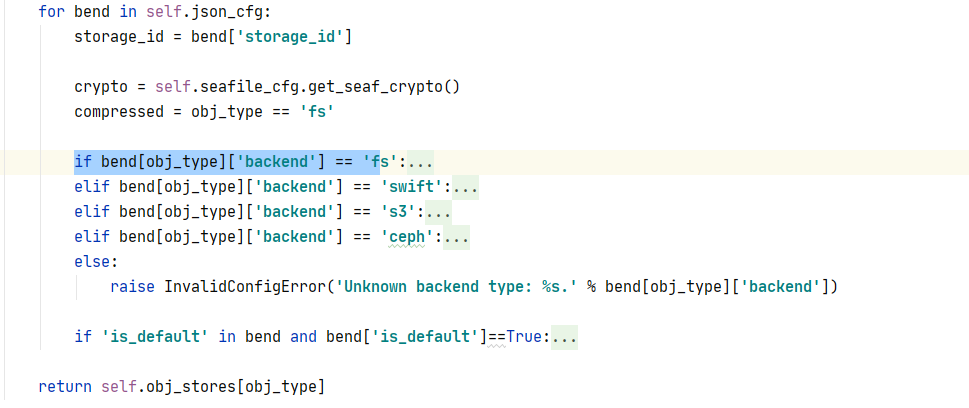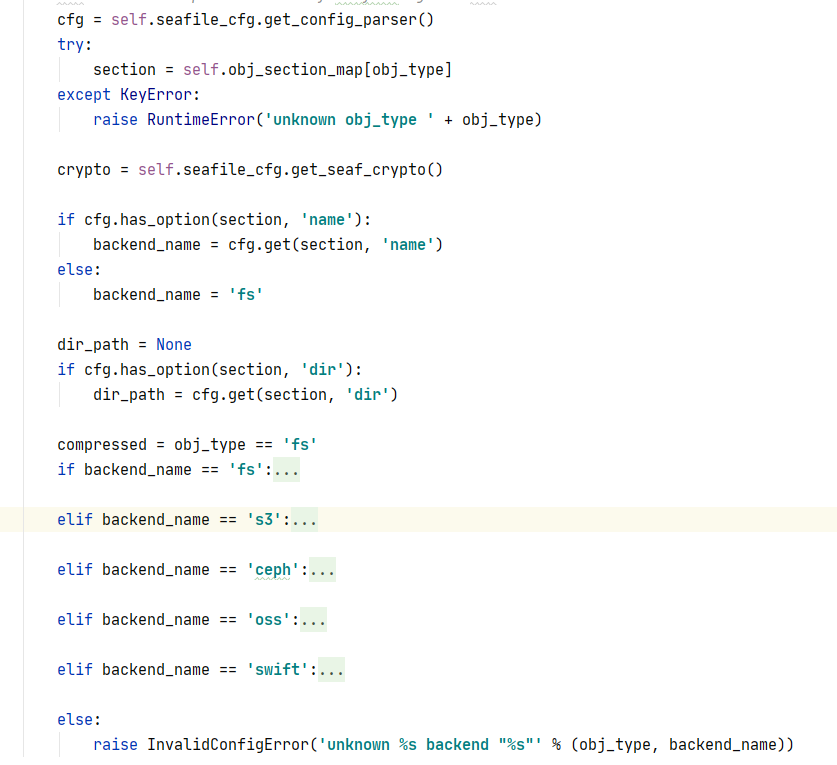2021SC@SDUSC
First, let's list the seafobj Directory:
backends utils __init__.py blocks.py commits.py commit_differ.py db.py exceptions.py fs.py objstore_factory.py
Open__ init __.py: see
from .commits import commit_mgr from .fs import fs_mgr from .blocks import block_mgr from .commit_differ import CommitDiffer
So let's first analyze exception.py and objstore_factory,db.py
db.py
There are three methods
create_engine_from_conf(config) init_db_session_class(config) ping_connection(dbapi_connection, connection_record, connection_proxy)
According to the calling relationship, the analysis will be carried out in the following order
ping_connection
cursor = dbapi_connection.cursor()
try:
cursor.execute("SELECT 1")
cursor.close()
except:
logging.info('fail to ping database server, disposing all cached connections')
connection_proxy._pool.dispose() # pylint: disable=protected-access
# Raise DisconnectionError so the pool would create a new connection
raise DisconnectionError()
create_engine_from_conf(config)
need_connection_pool_fix = True
Initially, the variable will be set to True, and the variable will become False under the following conditions
if not config.has_section('database'):
......
need_connection_pool_fix = False
So need_connection_pool_fix is determined by whether the config has a database
Then look at the if branch
seafile_data_dir = os.environ['SEAFILE_CONF_DIR']
if seafile_data_dir:
path = os.path.join(seafile_data_dir, 'seafile.db')
else:
logging.warning('SEAFILE_CONF_DIR not set, can not load sqlite database.')
return None
db_url = "sqlite:///%s" % path
You can see that you will look for seafile first_ data_ Dir. If the variable does not exist, logging will warn. And return None
Then look at the else branch
backend = config.get('database', 'type')
Get the type of config first
if backend == 'mysql':
elif backend == 'oracle':
else:
raise RuntimeError("Unknown database backend: %s" % backend)
It can be seen that these statements are mainly used to get the type of database. Take a look at the statements under mysql
if config.has_option('database', 'host'):
host = config.get('database', 'host').lower()
else:
host = 'localhost'
if config.has_option('database', 'port'):
port = config.getint('database', 'port')
else:
port = 3306
username = config.get('database', 'user')
passwd = config.get('database', 'password')
dbname = config.get('database', 'db_name')
db_url = "mysql+pymysql://%s:%s@%s:%s/%s?charset=utf8" % (username, quote_plus(passwd), host, port, dbname)
These are to get some config information.
The only difference between the statements under oracle and mysql is port.
Add pool recycle
kwargs = dict(pool_recycle=300, echo=False, echo_pool=False) engine = create_engine(db_url, **kwargs)
if need_connection_pool_fix and not has_event_listener(Pool, 'checkout', ping_connection):
# We use has_event_listener to double check in case we call create_engine
# multipe times in the same process.
add_event_listener(Pool, 'checkout', ping_connection)
return engine
init_db_session_class method
Configure the Session class of mysql according to the configuration file
try:
engine = create_engine_from_conf(config)
except configparser.NoOptionError as xxx_todo_changeme:
configparser.NoSectionError = xxx_todo_changeme
raise RuntimeError("invalid seafile config.")
The above create was called_ engine_ from_ Conf (config) method
# reflect the tables Base.prepare(engine, reflect=True) Session = sessionmaker(bind=engine) return Session
At this point, the db.py file has been analyzed. The function of this file is to configure the session file for the database according to config
exceptions.py
This file clearly declares a series of exception s about seafile
First declare a seafbjeexception (Exception) class, and the base class is the Exception class
class SeafObjException(Exception):
def __init__(self, msg):
Exception.__init__(self)
self.msg = str(msg)
def __str__(self):
return self.msg
After that, all classes and base classes are seafobjeexception
class InvalidConfigError(SeafObjException): #This Exception is rasied when error happens during parsing Parsing error exception
class ObjectFormatError(SeafObjException): #This Exception is rasied when error happened during parse object An exception occurred while parsing the object
class GetObjectError(SeafObjException): #This exception is raised when we failed to read object from backend. Exception reading object from backend
class SwiftAuthenticateError(SeafObjException): #This exception is raised when failed to authenticate for swift. swfit Authentication failed
class SeafCryptoException(SeafObjException): #This exception is raised when crypto realted operation failed. Encryption related work failed
objstore_factory.py
Because of the reference statement, let's go to the filesystem file first
from seafobj.backends.filesystem import SeafObjStoreFS
At the same time. There are also reference statements in the filesystem file
from .base import AbstractObjStore
We continue to trace back to the base file
Base.py
You can see that the base file has only one class, AbstactObjStore
class AbstractObjStore(object):
'''Base class of seafile object backend'''
You can see that this class is seafile Back end base class for
The methods include
__init__ read_obj read_obj_raw get_name list_objs obj_exists write_obj stat stat_raw
Supplementary knowledge: not implemented error
Method or function hasn't been implemented yet.
The following methods only throw this exception, and the rest are implemented in the following subclasses
read_obj_raw
Reads the original content of the object from the back end.
get_name
Gets the backend name for display in the log
list_objs
List all objects
obj_exists
given repo_id,obj_id,See if the object exists
write_obj
Write data to target backend
stat_raw
read_obj
call read_obj_raw method
Then there are two if statements
if self.crypto:
data = self.crypto.dec_data(data)
if self.compressed and version == 1:
data = zlib.decompress(data)
The whole method is wrapped in the try\catch block, and GetObjectError() will be thrown
stat
if self.crypto or self.compressed:
try:
data = self.read_obj(repo_id, verison, obj_id)
return len(data)
except:
raise
return self.stat_raw(repo_id, obj_id)
FileSystem.py
The core code in the file system is class SeafObjStoreFS(AbstractObjStore). It can be seen that this object inherits the AbstractObjStore class in Base.py, so many class methods need to be defined
Look at objstore again_ factory.py
Structure of the file
get_ceph_conf(cfg,section): get_ceph_conf_from_json(cfg): get_s3_conf(cfg,section): get_s3_conf_from_json(cfg): get_oss_conf(cfg,section): get_swift_conf(cfg,section): get_swift_conf_from_json(cfg): class SeafileConfig(object) class SeafObjStoreFactory(object): get_repo_storage_id(repo_id):
Start with the SeafObjStoreFactory class
SeafObjStoreFactory
obj_section_map = {
'blocks': 'block_backend',
'fs': 'fs_object_backend',
'commits': 'commit_object_backend',
}
Then look at the init method
def __init__(self, cfg=None):
self.seafile_cfg = cfg or SeafileConfig()
self.json_cfg = None
self.enable_storage_classes = False
self.obj_stores = {'commits': {}, 'fs': {}, 'blocks': {}}
Empty SeafileConfig class first
cfg = self.seafile_cfg.get_config_parser()
if cfg.has_option ('storage', 'enable_storage_classes'):
View get in SeafileConfig_ config_ Parser method
def get_config_parser(self):
if self.cfg is None:
self.cfg = configparser.ConfigParser()
try:
self.cfg.read(self.seafile_conf)
except Exception as e:
raise InvalidConfigError(str(e))
return self.cfg
You can see that the configparser object is returned
enable_storage_classes = cfg.get('storage', 'enable_storage_classes')
if enable_storage_classes.lower() == 'true':
Get the property from the configuration and view the property
from seafobj.db import init_db_session_class
self.enable_storage_classes = True
self.session = init_db_session_class(cfg)
try:
json_file = cfg.get('storage', 'storage_classes_file')
f = open(json_file)
self.json_cfg = json.load(f)
except Exception:
logging.warning('Failed to load json file')
raise
Keep watching get_obj_stores() method
def get_obj_stores(self, obj_type):
try:
if self.obj_stores[obj_type]:
return self.obj_stores[obj_type]
except KeyError:
raise RuntimeError('unknown obj_type ' + obj_type)
If obj__ If the type is wrong, an error is reported
The following code structure

You can see that different treatments are given for different types
In the specific processing, the methods are similar, and only the processing of fs is analyzed.
obj_dir = os.path.join(bend[obj_type]['dir'], 'storage', obj_type) self.obj_stores[obj_type][storage_id] = SeafObjStoreFS(compressed, obj_dir, crypto)
As you can see, create a new object and store it in obj_stores object.
Then analyze get_obj_store method
Return a SeafileObjStore Implementation of
The code structure is as follows, which is similar to the method structure above

You can see that other methods are SeafObjStoreFactory class services.
So far, we have analyzed the basic architecture of these three files, and will update this article after a deeper understanding of the project